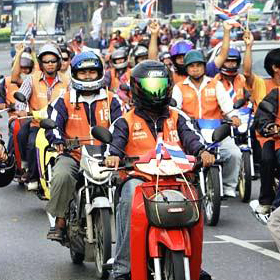
Bangkok, the capital of Thailand, has been undergoing rapid urbanization and industrialization, especially since the 1960s. Like other fast-growing cities, Bangkok has an ever-increasing vehicle fleet contributing to serious traffic congestion and aggravating air pollution. As a result of the enforcement of several air pollution standards in the period from 1993 to 2004, the use of cleaner four-stroke motorcycle engines was encouraged and polluting two-stroke engines displaced.
Motorcycles are a popular, easy and inexpensive mode of transport for carrying people and goods. At the same time, they have been major contributors to air pollution in Bangkok. In the early 90s, motorcycles in Bangkok numbered about 1.3 million, were increasing at a rate of 10-15 per cent per annum and constituted almost 50 per cent of the total fleet of vehicles.
In Bangkok, motorcycles were considered to be the largest mobile source of hydrocarbon (HC) emissions (at 70 per cent ), contributed 30 per cent of the carbon monoxide (CO) and 14 per cent of the particulate matter less than 10 microns in diametre (PM10) originating from mobile sources in 1997. The motorcycles are of two categories based on whether the engine is two-stroke or four-stroke. Four-stroke engines have several benefits over their two-stroke counterpart, such as the following:
- Four stroke engines emit half as much HC and suspended particulate matter (SPM) as do the two–stroke types; and
- Four-stroke has improved fuel economy, created less noise, has a comparable price and established technology, although the two-stroke motorcycles have lower engine weight, smaller size, higher output and greater operating smoothness than four-stroke ones.
To encourage the use of four-stroke motorcycles in Thailand, particularly in Bangkok, the city administration BMA (Bangkok Metropolitan Administration) adopted the regulatory measures of emission standards accompanied by other tools, such as institutional arrangements, stakeholders’ participation and awareness/capacity building programmes that assist in reducing emissions. After adopting the first emission standard for motorcycles in 1993, Thailand implemented a fifth new standard in 2004. Following enforcement of the stricter new vehicle emission
regulations, in recent years there has been a sharp rise in four-stroke motorcycle sales in the country.
Because four-stroke engines are more fuel-efficient than two-stroke ones, the shift from two- to four-stroke engine motorcycles will reduce the rate of major urban air pollutants, and could be beneficial as well for other cities striving hard for a higher growth rate with fewer adverse effects on the environment.
It is clear that motorcycle emission standards play an important role in reducing vehicular pollution. Through the enforcement of these standards, the use of cleaner four-stroke engines can be encouraged and polluting two-stroke engines can be displaced. Regulatory measures accompanied by other tools, such as institutional arrangements, stakeholders’ participation and awareness/capacity building programmes clearly assist in reducing emissions.
Case study courtesy of the UNEP Publication, Reducing Emissions from Private Cars: Incentive measures for behavioural change.